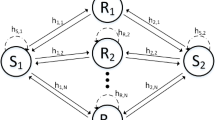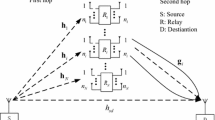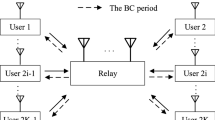Abstract
In this paper, we investigate the performance of an amplify-and-forward multi-input multi-output two way relay network where two sources are equipped with multiple antennas employing maximal ratio transmission and the communication is carried through the selected relay resulting in the largest received power. Assuming the fading channel coefficients are Nakagami-m distributed, we derive the sum symbol error rate (SSER), outage probabilities for each user and the overall system. In addition, diversity and array gains are obtained using the derived asymptotic SSER and system outage probability (OP) expressions. With the help of asymptotic system OP, we find the optimum location of relay by solving the convex optimization problem. Furthermore, we investigate the impact of limited feedback and imperfect channel estimations on the performance of the proposed structure. Finally, theoretical findings are validated by simulation results.







Similar content being viewed by others
References
Nosratinia, A., Hunter, T. E., & Hedeyat, A. (2004). Cooperative communication in wireless networks. IEEE Communications Magazine, 42, 74–80.
Laneman, J. N., Tse, D. N. C., & Wornell, G. W. (2004). Cooperative diversity in wireless networks: Efficient protocols and outage behavior. IEEE Transactions on Information Theory, 50(12), 3062–3080.
Rankov, B., & Wittneben, A. (2007). Spectral efficient protocols for half duplex fading relay channels. IEEE Journal on Selected Areas in Communications, 25(2), 379–389.
Popovski, P., & Yomo, Y. (2007). Wireless network coding by amplify-and-forward for bi-directional traffic flows. IEEE Communications Letters, 11(1), 16–18.
Guo, H., Ge, J., & Ding, H. (2011). Symbol error probability of two-way amplify-and-forward relaying. IEEE Communications Letters, 15(1), 22–24.
Upadhyay, P. K., & Prakriya, S. (2011). Performance of analog network coding with asymmetric traffic requirements. IEEE Communication Letters, 15(6), 647–649.
Yang, J., Fan, P., Duong, T. Q., & Xianfu, L. (2011). Exact performance of two-way AF relaying in Nakagami-m fading environment. IEEE Transactions on Wireless Communications, 10(3), 980–987.
Jia, X., & Yang, L. (2012). Upper and lower bounds of two-way opportunistic amplify-and-forward relaying channels. IEEE Communications Letters, 16(8), 1180–1183.
Guo, H., & Ge, J. (2011). Performance analysis of two-way opportunistic relaying over Nakagami-m fading channels. Electronics Letters, 47(2), 150–152.
Zhang, C., Ge, J., Li, J., & Yun, H. (2013). Performance evaluation for asymmetric two-way AF relaying in Rician fading. IEEE Wireless Communications Letters, 2(3), 307–310.
Liu, W., & Yang, L. (2014). Performance analysis for two-Way relaying networks with and without relay selection. Wireless Personal Communications, 75(4), 2485–2494.
Yang, Y., Ge, J., & Gao, Y. (2011). Power allocation for two-way opportunistic amplify-and-forward relaying over Nakagami-m channels. IEEE Transactions on Wireless Communications, 10(7), 2063–2068.
Yang, Y., Ge, J., Ji, Y. C., & Gao, Y. (2010). Performance analysis and instantaneous power allocation for two-way opportunistic amplify-and-forward relaying. IET Communications, 5(10), 1430–1439.
Nasab, E. S., & Ardebilipour, M. (2013). Multi-antenna AF two-way relaying over Nakagami- m fading channels. Wireless Personal Communications, 73(3), 717–729.
Guo, H., & Wang, L. (2011). Performance analysis of two-way amplify-and-forward relaying with beamforming over Nakagami-m fading channels. Wireless Communications Network and Mobile Computing, China, 1–4.
Yadav, S., Upadhyay, P. K., & Prakriya, S. (2014). Performance evaluation and optimization for two-way relaying with multi-antenna sources. IEEE Transactions on Vehicular Technology. doi:10.1109/TVT.2013.2296304.
Yang, N., Yeoh, P. L., Elkashlan, M., Collings, I. B., & Chen, Z. (2012). Two-way relaying with multi-antenna sources: Beamforming and antenna selection. IEEE Transactions on Vehicular Technology, 61(9), 3996–4008.
Yang, K., Yang, N., Xing, C., & Wu, J. (2013). Relay antenna selection in MIMO two-way relay networks over Nakagami-m fading channels. IEEE Transactions on Vehicular Technology. doi:10.1109/TVT.2013.2291323.
Lo, T. K. Y. (1999). Maximum ratio transmission. IEEE Transactions on Communications, 47(3), 1458–1461.
Ikki, S. S., & Aissa, S. (2012). Two-way amplify-and-forward relaying with Gaussian imperfect channel estimations. IEEE Communications Letters, 16(7), 956–959.
Erdogan, E., & Gucluoglu, T. (2015). Simple outage probability bound for two-way relay networks with joint antenna and relay selection over Nakagami-m fading channels. Electronics Letters, 51(5), 415–417.
Ikki, S. S. (2012). Optimization study of power allocation and relay location for amplify-and-forward systems over Nakagami-m fading channels. Transactions on Emerging Telecommunications Technology, 25(2), 334–342.
Ma, Y., Zhang, D., Leith, A., et al. (2009). Error performance of transmit beamforming with delayed and limited feedback. IEEE Transactions on Wireless Communications, 8(3), 1164–1170.
Guo, J., & Pei, C. X. (2014). Relay networks in the presence of channel estimation errors and feedback delay. Wireless Personal Communications, 79(3), 1803–1813.
Amin, O., Ikki, S., & Uysal, M. (2011). On the performance analysis of multirelay cooperative diversity systems with channel estimation errors. IEEE Transactions on Vehicular Technology., 60(5), 2050–2059.
Simon, M. K., & Alouni, M. S. (2005). Digital communication over fading channels (2nd ed.). New York: Wiley.
Gradhsteyn, I. S., & Ryzhik, I. M. (2007). Table of integrals series and products (7th ed.). London: Academic Press.
Oldham, K. B., Myland, J., & Spanier, J. (2008). An atlas of functions with equator the atlas function calculator (2nd ed.). Berlin: Springer.
Wang, Z., & Giannakis, G. B. (2003). A simple and general parameterization quantifying performance in fading channels. IEEE Transactions on Communications, 51(8), 1389–1398.
Goldsmith, A. (2005). Wireless communications. Cambridge: Cambridge University Press.
Acknowledgments
This work is supported by the Scientific and Technological Research Council of Turkey under research grant 113E229.
Author information
Authors and Affiliations
Corresponding author
Rights and permissions
About this article
Cite this article
Erdoğan, E., Güçlüoğlu, T. Performance Analysis of Maximal Ratio Transmission with Relay Selection in Two-way Relay Networks Over Nakagami-m Fading Channels. Wireless Pers Commun 88, 185–201 (2016). https://doi.org/10.1007/s11277-015-3086-7
Published:
Issue Date:
DOI: https://doi.org/10.1007/s11277-015-3086-7




